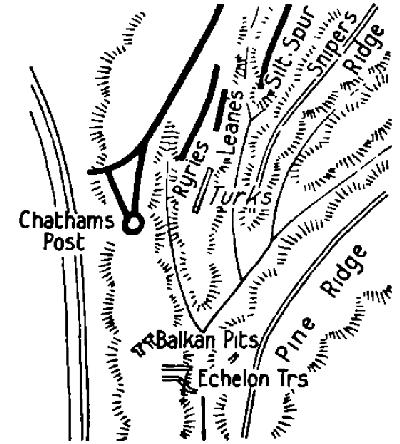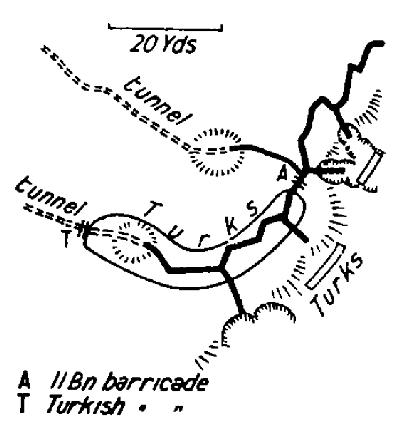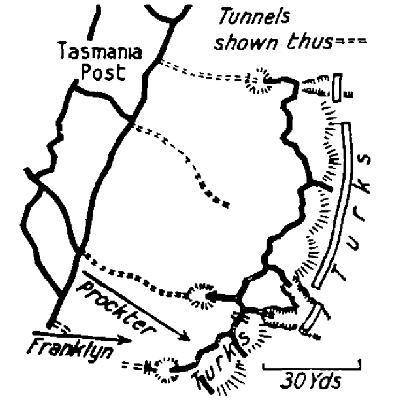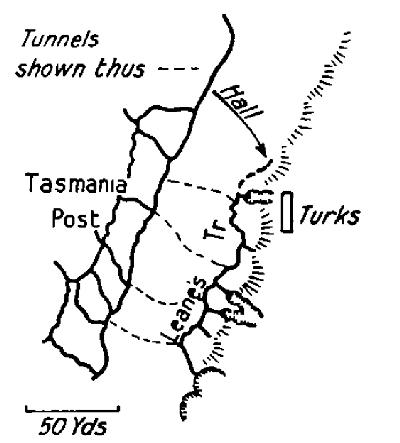Topic: BatzG - Aug 1915
The August Offensive
Gallipoli, August 1915
Bean, Part 1, Leane's Trench

The following extract is from Bean, C.E.W., The Story of Anzac, Vol. II , 1924, pp. 489 - 496:
Chapter XVII
LEANE'S TRENCH
The night of August 5th was a somewhat disturbed one. Preceding as it did the opening day of the offensive, it was, on the Anzac side, a time of anxious preparation. While part of the infantry was obtaining its last sleep before the battle, the 29th Indian and 29th British Brigades were being landed on the Beach. The last loads of stores were being hurried to advanced dumps close behind the points of attack. In the secret underground galleries in front of the Pimple, from which the first line of the attack on Lone Pine was to be launched, engineers and infantry were toiling by candle-light, taking out the packing of sandbags which had been temporarily left in the recesses, and preparing to break down the roof and make the openings from which that line would emerge. The minds of officers and men were full of excited anticipation of open warfare, a move to Maidos and the Narrows, and possibly to Constantinople. The previous week's attack upon Leane's Trench had been almost forgotten.
But, though the Australians did not realise it, the enemy had regarded the loss of Leane's as a serious reverse. Not only was it against his settled principle to yield any ground, but Birdwood's policy had succeeded in drawing his attention to the south of Anzac, and special orders had been given to the Turks to fortify that flank against the possibility of an outbreak of the Anzac force. The loss of Leane's at this juncture was taken deeply to heart. The two company commanders of the 48th Regiment who were held responsible are said to have been court-martialled, and one of them sentenced to death, while a third appears to have volunteered to retake the trench and to have expressed his willingness, in the event of failure, to allow the Turkish machine-guns to be turned upon himself and his men. Whether or not these statements, subsequently made by prisoners, are true, orders were given for the counter-attack. It was to be covered by artillery and by the machine-guns of the 47th Regiment on Lone Pine and Snipers' Ridge; "if the Turkish troops ... failed to stand firm ... or ran away," these machine-guns were to fire upon The trench was to be destroyed by artillery overnight and attacked at dawn on August 6th. A copy of the order by Rushdi Bey (commander of the 16th DIV.) to this effect was captured. The 77th and part of the 48th Regts., in the sector from Pine Ridge to Gaba Tepe, were also to cover the attack by firing upon the trencher opposite them. The 3/13th, part of the 5th Turkish Div., then acting as reserve for the Anzac zone, was to move to Pine Ridge to the position vacated by the attacking companies of the 48th.
At 6 p.m. on August 5th the Turkish artillery on Gun Ridge opened upon Leane's Trench, then occupied by part of a company of the 11th under Captain Rockliff. The bombardment was one of the fiercest experienced at Anzac, but the trajectory of most of the shells was too flat for them to be dangerous, their high-explosive merely blowing down the sandbag parapet. The Olive Grove battery, far more effective because it was firing in enfilade, opened also, but not so heavily. At 7 o'clock the bombardment ceased, only two men having been wounded.
Half the garrison of the trench consisted of reinforcements who had been poured in from Egypt in anticipation of the coming offensive. Rockliff went along the trench distributing the men alternately - old soldier – reinforcement - old soldier- reinforcement. No assault followed, but the bombardment had been so sharp that it seemed probable that one was impending. Yet five yards from the edge of the trench the valley fell so abruptly that it was impossible to see into it; the only means of detecting an enemy moving in the gully was therefore by sound. But the picks which were then busily at work, preparing the trench for the delivery of a fusillade the next day, prevented hearing. Rockliff explained this at battalion headquarters, but was told that the work, being connected with the next day's offensive, must proceed. Nevertheless, on returning to the trench, he stopped it. At midnight, when his company commander, Captain Boyd Aarons," relieved him on duty, it was recommenced.
About dawn someone in the trench heard an order given by a Turkish officer close beneath in the valley. Some of the 11th fired and threw bombs in the direction of the sound. A few minutes later a hail of machine-gun fire .burst upon the parapet; shells began to explode around it; heavy rifle-fire was poured upon the whole front; and a volley of Turkish bombs burst in the southern end of the trench. The enemy had crept unperceived up his old communication trenches and the Y-shaped washaway and was fiercely attacking.
One of the Turkish machine-gunners has recorded that they could see their men on the slope below Leane's harassed by a fierce bomb-fire, which at first appeared to prevent them from climbing over the parapet. Possibly also the Turkish artillery, which seems to have been shelling the southern end of the trench, at first kept the Turks back. But presently this fire lifted. A shell, or a volley of bombs, had killed or wounded almost every Australian at that end of the trench, and about thirty of the enemy scrambled over the parapet. One of the surviving Australians, by name Smith, ran back through the southernmost communication tunnel to Tasmania Post to bring supports; but, when returning through the tunnel, he heard in front of him the click of a rifle-bolt. Realising that the enemy was in the passage, he stationed himself with several comrades at a bend of the tunnel, preventing penetration. Meanwhile all the men who could be spared from Tasmania Post were rushed forward into Leane's through a tunnel farther north, led by Lieutenant Robertson,'" one of the newly-arrived reinforcements.
These supports found Leane's Trench a shambles. The southern end of it was paved with killed and wounded. The bags on the parapet had been cut to ribbons by machine-gun fire, and the sand and gravel poured into the trench. To show a head above the parapet was almost certain death. Mean- while, though the Turks had only entered its southern end, another force of them was so close to its central sector that their bayonets could be seen above the parapet, and also their hands as they flung bombs. The Australians in the trench had at this juncture only eight jam-tin grenades and no matches with which to light the fuses. An automatic cigarette-lighter was, however, obtained from Captain Boyd Aarons, and, as the last of the bombs was flung, a further supply came to hand.
The Australians, who by shooting into the trench-wall at a bend had been preventing the enemy from working north wards, now began throwing bombs over the angle, while Sergeant Wallish hastily piled across the trench a barricade over which bomb fighting continued. Robertson was killed. Wallish though was wounded, continued to fight on until his leg was shattered. Boyd Aarons, endeavouring to smother a Turkish bomb by covering it with a blanket and sandbag, was wounded in the knee.
About 6 o'clock, the Turks still being in the southern end of the trench, the officer commanding the 11th informed his brigadier, MacLagan, that the enemy could not be driven out. MacLagan ordered him to prepare a counter-attack, and, the matter seeming urgent, himself proceeded to Tasmania Post, where he took charge of the arrangements. Two parties, each of about twenty-five men, had been already organised under Lieutenants Prockter and Franklyn. MacLagan directed that Prockter's party should dash across the open from the southern end of Tasmania Post, while Franklyn's stood ready instantly to support it. The charge was at once made. Prockter's men, who were largely reinforcements, had no more than forty yards to traverse, but were met by heavy fire. Tunnels
Part of them, missing the trench, ran south of it into the gully, and were killed by the enemy's machine-guns. About half the party-mostly wounded and too few to assault the trench successfully-reached the parados and flung themselves down behind it. Two newly arrived reinforcements, named Johns and Morrison and could be seen coolly rising and firing rapidly into the trench or the gully and then sheltering again. A third, named Roper was near them, firing from a kneeling position and then turning to those in Tasmania Post and giving the signal to reinforce.

As the first rush had failed, MacLagan ordered Franklyn to charge. This party was met with even heavier fire than the first, but most of it reached the parados and stood for a moment firing down. Then, as the enemy fell or spread, the survivors of both parties jumped into the trench. All the enemy in it were killed, but six were captured in the tunnel. Of the parties which made this gallant counter attack, both had suffered heavily. Both officers were mortally In Prockter's party of 26, 8 were killed and 18 wounded, the gallant Johns and Morrison both losing their lives.
Thus by about 7 o'clock the trench had been cleared of the enemy, but Turks were still clinging to the slope below its centre and northern end, although they had not yet made any rush over the crest. Their position was, in fact, one of extreme difficulty, since shortly after daylight the 10th Battalion on Silt Spur, which enfiladed the valley, had been ordered to maintain rifle-fire down the gully in rear of them, and at 5.30 some of the Anzac batteries also had been turned upon it. The Turks sheltered from this fire in the washaways close beneath the parapet of Leane's, but were not in a favourable position to continue the assault. Meanwhile two men of the 11th, Privates Cockings and Moran, who had found loop-holes from which they could see into parts of the washaways through certain breaks in their banks, were steadily shooting every man who passed. It was also observed that, when the Turks attempted to break back in twos and threes to the valley, their own machine-guns from the rear were cutting them down.
Nevertheless the existence of the enemy in force so close beneath the trench caused some anxiety. If reinforced. it seemed likely that he would attempt to rush the trench, in which case the field of fire, only five yards in width, gave little room for repelling him. Moreover the sound of picking, heard at about 8 o'clock from one of the tunnels, suggested that the Turks were driving a mine into the hillside. Major Clogstoun of the engineers was sent for, and endeavoured to discover what the Turks were about. In doing so he daringly leant over the parapet and was at once shot through the windpipe. MacLagan, who on hearing the same report had again gone forward to Leane's, could find no evidence of mining; but he saw that it was difficult to dislodge the enemy, since the jam-tin bombs thrown by the 11th rolled down the hill and burst out of range. "Throw some gun-cotton at them," he said to Boyd Aarons, who, though wounded, was still in charge. A small box of this explosive, prepared for use as a bomb, was accordingly rolled over the parapet. It exploded, killing some half-dozen of the enemy, and the threat of attack ended.

Meanwhile, however, the commander of the 11th had ordered another step to be taken to oust the digging Turks. This was a charge over the open north of Tasmania Post by twenty-five men under a reinforcement officer, Lieutenant Hall. This party accordingly dashed forward through the Wheatfield. The morning was advanced. The whole area was on the alert. As they reached the edge of the slope the machine guns on Snipers' Ridge and the Knife Edge, and shrapnel-fire from a Turkish battery, were turned upon them. Hall was struck, and pitched headlong down the slope. A number of his men charged or stumbled down it, ten of their bodies being afterwards found near its foot. A body of the enemy, which they surprised, fled on their appearance, and, as it recoiled, the crackle of the Turkish machine-guns swelled into a deafening uproar. But of Hall's party only three wounded men managed to return to the northern end of Leane's.
In case the enemy might rally, the fire of howitzers was now directed upon the lower part of the Valley of Despair. A few bombs continued to be thrown by some of the enemy lingering beneath the trench. The action died out about 10.30. It had cost the Australians 55 killed and 100 wounded. The enemy's losses were probably equal.

Urgent steps were at once taken to put Leane's Trench into such a condition that its garrison could that afternoon take their allotted part in helping to cover with rifle-fire the attack upon Lone Pine. The artillery was already carrying out the third and last day's programme of slow bombardment of the Pine and other positions. Since the previous night the 1st Infantry Brigade had been resting in its support line, the 2nd Brigade having been extended so as to take over its entire front. The 2nd Field Company, which for the past week had teen cutting a new sap to the Pimple, widening the old ones, and deepening and preparing the tunnels, was now in full force breaking open the roof of the underground firing line opposite the Pine. Water and supplies had been stored in Brown's Dip, immediately in rear of the Pimple. The men of the 1st Brigade had crammed their belongings into their packs and stacked these in convenient dBp8ts behind the lines. Bayonets had been sharpened; broad white patches of calico had been sewn by all troops round the sleeves and on the backs of tunics to serve as distinguishing marks by night. The plans had been explained by the officers to the men. At 2 p.m. the 2nd Field Company finished the opening of the underground line. At 2.30 p.m. the portion of the 2nd Brigade which had been garrisoning the Pimple was withdrawn to the flanks, and the 1st moved in to take up its allotted position for the attack upon Lone Pine. Meanwhile the 7th Battalion was held ready to launch, at short notice, an attack upon Johnston's Jolly, this provision being insisted on by General Birdwood, although General Walker was adverse. The powerful influence of Colonel White had been exercised, as on numerous occasions later in the war, for cutting-down any part of the plan which he considered tactically impracticable or beyond the power of the available troops. The opposition of himself, Walker, and Ryrie, maintained till the commencement of the offensive, undoubtedly caused a curtailment of the projected feint, which would otherwise have included both a prior assault on Holly Ridge and an attack on the Jolly simultaneous with that upon the Pine.
Further Reading:
The August Offensive, Gallipoli, August 1915
The August Offensive, Gallipoli, August 1915, Australian Imperial Force, Roll of Honour
Battles where Australians fought, 1899-1920
Citation: The August Offensive, Gallipoli, August 1915, Bean, Part 1, Leane's Trench



